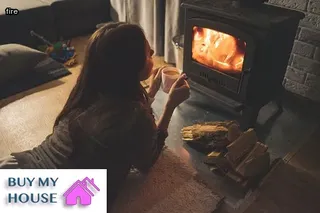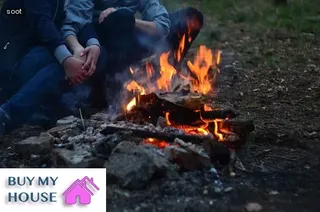Kitchen fires are unfortunately a common occurrence, and can cause significant damage to your home. Most kitchen fires are caused by cooking, with grease and oil being the leading factors.
Food left unattended on a stove, oven or other source of heat can quickly overheat and ignite. Electrical appliances that are not properly maintained, such as toasters and microwaves, can also be hazardous when not used correctly.
Other causes of kitchen fires include leaving combustible items too close to heat sources such as ovens or stoves; failing to turn off burners after use; or failing to keep flammable substances away from sources of heat. It is important to take the proper precautions in the kitchen to prevent fires from occurring, but if one should occur quick action is needed in order to minimize damage.

Grease fires can occur quickly and can cause severe damage to your kitchen and home. Grease is highly flammable, making it easy for a small flame or spark to ignite the grease, leading to an intense fire.
Grease fires burn hotter than other types of fires, making it harder to extinguish. It's important to understand the dangers of grease fires and take steps to prevent them from occurring in the first place.
When cooking with oil or other greasy substances, keep a lid handy that fits the size of your pan in case you need to smother the fire. Avoid using water on a grease fire as this will spread the flames across the surface of the pan instead of extinguishing them.
If a grease fire does occur, turn off all heat sources immediately and evacuate everyone from the area if possible. A Class B dry chemical extinguisher should be used on a grease fire if one is available - never use an extinguisher labeled for wood or paper fires on a grease fire as this could make it worse.
Once the fire is out, assess any damage caused by smoke and soot before beginning any cleanup process.
Fire extinguishers are an important tool for preventing and recovering from kitchen fire damage. A fire extinguisher should be placed in an easily accessible location near the kitchen, such as on a wall or in a cabinet.
Fire extinguishers are typically filled with water, carbon dioxide, foam, or dry chemical, and they can be used to put out small kitchen fires. When using a fire extinguisher, always remember to stand at least six feet away from the fire and aim the nozzle at the base of the flames.
Additionally, it is important to turn off any nearby appliances or sources of fuel as soon as possible to prevent further damage. It is also crucial to get out of the house immediately if there is any smoke present.
After a kitchen fire has been extinguished, it is essential to assess any potential damage caused by heat or smoke and contact appropriate professionals for repairs if necessary.

When a kitchen fire occurs, it is important to respond quickly and safely. To prevent the fire from spreading, remain calm and remember to turn off gas or electricity if possible.
Immediately evacuate the building if necessary, leaving all doors and windows closed. If safe to do so, use an extinguisher such as baking soda or water to put out the flames.
If you are unable to put out the fire, call 911 for help and stay outside until firefighters arrive. After a kitchen fire, the damage can be incredibly difficult to recover from both physically and mentally.
All furniture should be immediately removed in order to assess any structural damage that may have been caused by smoke or heat. Fire damage restoration professionals should then be called in to clean up the area of soot, smoke residue, and leftover hazardous materials.
Fire damaged items such as carpets and furniture should also be replaced where necessary in order to restore safety in your home.
In the event of a kitchen fire, it is vital to take immediate steps to contain and extinguish the fire. To start, turn off the heat source if possible, such as an oven or stove.
If you are able, cover the flames with a non-flammable lid or pan. Try to keep all combustible items away from the fire and be sure not to use water on any electrical appliance fires.
It is best to smother small fires with baking soda or a fire blanket when possible. Additionally, if appropriate for the size and type of fire, use a Class B dry chemical extinguisher.
In the event that you cannot contain the kitchen blaze yourself, evacuate immediately and call your local fire department for assistance. Following these steps can help reduce damage from kitchen fires and prevent further harm to your home and family members.

The most important thing to do after a kitchen fire is to minimize the damage. Immediately turn off any sources of fuel such as the gas or electricity, and open windows and doors to reduce smoke damage.
If possible, cover furniture with a drop cloth in order to protect it from ash and soot. The next step is to contact your insurance provider right away in order to start the claims process.
After that, contact an experienced professional who specializes in fire damage restoration. This will help ensure that all necessary steps are taken for proper recovery.
Fire damage can have lasting consequences on your home if not properly addressed, so it's important to take these steps quickly and efficiently in order to limit any additional harm.
When dealing with the aftermath of a kitchen fire, it is important to take the necessary steps for proper recovery. First, you should contact your insurance company as soon as possible and document any damage that has occurred.
It is also important to make sure the fire has been completely extinguished. If there is smoke or soot, open windows and doors to provide ventilation and hire a professional cleaner to remove the residue, if needed.
You will want to thoroughly clean all surfaces with mild soap and warm water and dispose of any food items that were near the fire or may have been exposed to smoke or heat. When it comes to appliances, it is wise to consult a qualified technician who can assess whether they are safe to use again.
Finally, check your home’s wiring system for any problems that could have caused the fire in the first place and have an electrician come out for repairs if needed. Taking these steps can help ensure you get back into your kitchen quickly and safely after a kitchen fire.

Before using an oven or stove after a kitchen fire, it is essential to take the necessary steps to prevent further damage and ensure safety. First, if possible, shut off the power to the appliance before attempting any repairs.
Second, inspect the oven or stove for visible signs of damage such as burn marks, melted wires, and soot. Third, clean out any debris from inside the appliance and replace any damaged wiring before turning it back on.
Fourth, check for gas leaks in gas ranges by smelling for gas at the burner control knobs and other connections. Fifth, have a professional inspect all major appliances before use to make sure they are properly installed and functioning correctly.
Lastly, always make sure that combustible materials are kept away from the appliance while in use to avoid accidental fires. Taking these steps will help ensure that your appliance is safe to use after a kitchen fire and can save you from costly repairs or worse in the future.
When it comes to preventing and recovering from kitchen fire damage, smoke detectors and sprinkler systems are essential components of any safety plan. Smoke detectors can detect the presence of smoke in a kitchen before a fire spreads, giving you time to evacuate the premises and call for help.
Sprinkler systems can be used to contain the flames and help minimize damage before firefighters arrive. Both smoke detectors and sprinkler systems should be regularly tested, maintained, and kept up-to-date according to the manufacturer's instructions.
It is also important to ensure that all smoke detectors are interconnected so they will sound off at the same time if smoke is detected in one area of the kitchen. When it comes to installing sprinklers, it is best to consult with a professional who can assess your home's layout and determine which type of system is right for you.
Having these two components in place can make all the difference when it comes to protecting your family from kitchen fire damage.

Inspecting your home after a kitchen fire is an important step in both preventing and recovering from the damage caused. Homeowners should immediately assess any visible damage to the kitchen and surrounding areas, as well as investigate any hidden damage that may have occurred.
This includes checking for smoke or water damage in cabinets, walls, floors, and ceilings. After making sure all electrical outlets are off, it is crucial to inspect all appliances that were running when the fire started.
Additionally, check for signs of structural damage such as warped floors, weakened support beams and sagging ceilings. If there are signs of a gas leak or hazardous fumes present, contact your local fire department or utility company right away.
Lastly, make sure all smoke detectors are working properly and replace the batteries if needed. Taking these steps will help you prevent further destruction to your home while recovering from fire damage.
Inhaling smoke from cooking fires can present a serious health hazard, especially if the fire is not extinguished properly. In addition to causing physical damage to the kitchen, breathing in smoke from an uncontrolled blaze can be detrimental to one's health.
The inhalation of smoke particles causes inflammation of the respiratory system, which can lead to bronchitis or even pneumonia. Smoke inhalation may also cause difficulty breathing or other lung ailments such as emphysema and asthma.
Moreover, prolonged exposure to smoke can result in permanent scarring of the lungs and long-term respiratory problems. It is therefore important that individuals take precautions when attempting to put out a cooking fire in order to prevent these hazardous effects on their health.
To minimize exposure, it is important that proper ventilation be installed and regularly maintained in kitchens where frequent cooking takes place. Additionally, having a fire extinguisher on hand will help quickly put out any accidental blazes before they become unmanageable and cause more serious damage.

When dealing with insurance companies after a cooking fire incident, it is important to understand the policy coverage you have and the process of filing a claim. Start by taking pictures or videos of the damage and any items that were destroyed in order to receive compensation for them.
Reach out to your insurer as soon as possible to start the claims process; they will assign an adjuster who can come and assess the damage. Make sure to keep all documents related to the fire, including reports from firefighters, repair estimates and bills paid.
If you disagree with any part of their assessment regarding your coverage, you can always negotiate with them. Lastly, if your insurance company denies your claim or offers far less than what you expect, it is possible to appeal their decision.
With patience and dedication, you can get the compensation necessary for recovering from kitchen fire damage.
Maintaining your stove and oven is key to preventing fire damage in the kitchen. Inspecting your appliances regularly is an important first step in ensuring they are functioning properly.
Check for any loose or frayed wiring, corrosion, or other signs of damage that could be a potential fire hazard. It's also important to keep the area around your appliances clean and free of combustible materials such as paper towels, cleaning rags, oven mitts, etc.
This will help reduce the risk of accidental fires caused by sparks from a hot stovetop. Finally, make sure you always have working smoke detectors and a fire extinguisher in the kitchen to help contain any fires that do occur before they can cause significant damage.

Propane and gasoline are powerful fuels that can cause serious damage if handled improperly. Taking the right precautions when using either fuel in the kitchen is essential to preventing fire damage.
It's important to understand that propane and gasoline have different characteristics, so they should be treated differently. Propane is heavier than air, meaning it will sink and accumulate in low areas like basements or crawl spaces where it can easily ignite.
On the other hand, gasoline is lighter than air and will rise into the atmosphere, so ventilation is key to safely handling it indoors. In both cases, combustible materials should be kept away from these fuels as well as any open flames or sparks that could ignite them.
Additionally, all propane tanks should be inspected regularly for leaks, which can lead to an explosion or fire if ignited by a spark or flame. Finally, having an emergency plan in place for dealing with a kitchen fire is critical for quickly containing and extinguishing the blaze before too much damage occurs.
In the aftermath of a small kitchen fire, it is important to take immediate action to prevent further damage and expedite recovery. The first step is to turn off the power and gas to the affected area.
Once complete, contact your local fire department for confirmation that the fire is out and safe to begin restoration efforts. Once it has been determined that the area is safe, you should call a professional restoration company for help with removing smoke and soot from walls, floors, cupboards, and appliances.
It's also important to ensure that all surfaces are properly cleaned with an appropriate cleaning solution, such as detergent or disinfectant. Be sure to have any damaged items replaced as soon as possible in order to prevent mold or mildew growth.
Finally, if structural damage has occurred due to the fire, contact a qualified contractor who can assess and make any necessary repairs. By taking these steps immediately following a small kitchen fire incident you can help minimize damage and get your home back in order quickly.

After a kitchen fire, there are several items that may need to be replaced in order to prevent future damage and restore the room back to its original condition. Depending on the severity of the fire, you may need to replace cabinetry, appliances, countertops, flooring, walls, ceilings, and electrical wiring.
Additionally, all damaged items must be disposed of properly in order for the new fixtures and furnishings to be safely installed. If your kitchen has experienced smoke damage from a fire, it is important to have your air ducts professionally cleaned as well.
A professional restoration contractor can assess the damages and recommend specific replacements for your particular situation. The contractor can also help you find appropriate materials at an affordable price that will ensure your kitchen is as safe as possible after a fire.
The answer to whether it is safe to stay in a house after a kitchen fire depends on the severity of the fire, the extent of smoke and heat damage, and if there has been any structural damage. To prevent significant kitchen fire damage, it is important to practice fire safety in the home.
This includes keeping flammable items away from stovetops and open flames, being aware of potential hazards like loose wiring or faulty appliances, and installing smoke alarms. If a kitchen fire does occur, it is important to act quickly by evacuating the home immediately and calling 911.
After a kitchen fire has been extinguished, it is important to assess the level of damage before deciding whether or not it is safe to remain in the house. If there is extensive smoke or heat damage throughout the home, staying in the residence may not be an option due to potential health risks.
In addition, occupants should look out for signs of structural instability such as cracks in walls or ceilings that could collapse due to weakened supports caused by high temperatures during a kitchen fire. If these signs are present, seeking alternate housing may be necessary until repairs can be made.
If a fire starts in your kitchen, it is important to act quickly and calmly. First, determine if the fire is small enough to be extinguished with a fire extinguisher or baking soda.
If the fire is too large for these methods, evacuate the building immediately and call 911. Once all occupants are out of the burning structure, never re-enter until given an all clear by local firefighters.
If you have been able to put out the fire yourself, inspect your kitchen and appliances to make sure that they are safe before attempting to use them again. After any kitchen fire damage has been contained, contact your insurance provider as soon as possible so that they can assess the damage and begin repairs promptly.
Finally, take steps to prevent future kitchen fires by keeping combustibles away from heat sources, cleaning stovetops regularly, testing smoke alarms frequently and avoiding leaving cooking unattended. Taking these steps can help you protect yourself and your home from further damage due to kitchen fires.